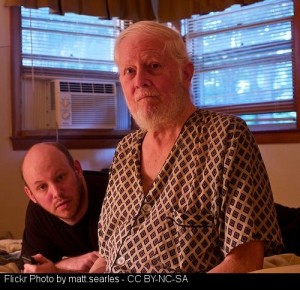By CYN LoPINTO
Editor-in-chief, gerontologist
________________________________________________________________________________
-

Patience is key for one-to-one activities - The role of a caregiver is one filled with endless physical and emotional responsibilities. Days are long and often occupied with pressing and important tasks. While it seems there is little time and even less energy available for planning creative activities, recreation can be an essential ingredient in assuring a positive caregiving relationship.
Why are activities so important? The activities we engage in tell others who we are and outwardly express our inner selves. Recreation can either excite us by getting our blood moving, or relax us by calming us down. Time almost always goes by quickly when we are doing something we enjoy and it can really break up the day. The major goal in any type of activity is to encourage growth, whether intellectually, socially or emotionally. For some people, specific activities that they enjoy do not change much throughout their lifetime. If they loved collecting stamps in the their 20s, they still love it now that they are 80. Other people’s interests change completely. My mother, for example, enjoyed sewing for her family most of her adult life. She made beautiful clothes for my sisters, brother, father and ever herself. But when we all grew up and moved out, she closed the lid on her sewing machine and that was that. She got bored with it and never looked back.
Other people, due to either physical or cognitive changes, need to make some adaptations in order to continue doing the things they enjoy. If you are caring for someone who loves working on crossword puzzles but their vision is deteriorating, you may want to purchase a strong magnifier or some large print puzzle books. Luckily, with today’s “baby boomers” passing middle age, there are many products hitting the market that help to adapt specific activities. It is a good time to be growing older!
One-to-one activities are the most time and energy consuming recreational choice out there. They are intense, but also very rewarding. It requires an understanding and trusting relationship between two equals. This could be between mother/daughter, father/son, husband/wife, activity director/resident, friend/friend or anything in between. It is basically a recreational opportunity encouraging bonding between one human being and another.
There are certain ideas to incorporate when engaging in any type of one-to-one activity. The following are some tools needed to assure a positive experience:
Don’t rush – Allow enough time to carry out the activity in the way you think it should be done. If you rush, the person you are spending time with will feel like what you are doing is a “chore” and not something you really want to do.
Don’t assume – Just because you think a person likes something, doesn’t mean that they like it. Ask them for their input. Both parties should be enjoying themselves and comfortable with the activity.
Use active listening – Remember to open the flow of communication and really pay attention to the wants and needs of the person with whom you are spending time with. They have a right to be heard.
Don’t play down, be equals – This is a give and take relationship. Trust is the key ingredient here.
Share – Let the relationship be a communion between the two of you. If sharing is only one-sided, then the relationship will suffer.
Use humor – Most situations can improve greatly if a little humor is added. If you take things “so seriously,” then everything seems much worse than it actually is. Try to keep things as light as possible and enjoy the time you have together. Remember it is supposed to be a time of fun. Keep in mind that humor has lots of therapeutic benefits as well. A good laugh does wonders for the immune system.
Keep confidentiality – Try to think of your recreational “sessions” as a special time between the two of you. If you blab confidential things shared between you and your loved one to others, you will lose the respect so important to the relationship. Again, this is a big trust issue.
Honor the person you are with – Make sure the specific activities you choose are ones that the person you are caring for sees as positive. For example, if your father thinks that baking a cake is a “woman’s” activity, then do something else. He has a right to his opinion, even if you do not agree. Always be respectful.
Help the person remember who he/she is – Even though the person you are caring for may have some serious disabilities and has been through a lot, you can bet that the core of what he/she was like at the age of 17, is still in there. None of us change all that much. We can help one another “get back” to the part that truly defines us. This is so important
| One-to-one activity ideas: | |
|
|
Cynthia Lopinto
Latest posts by Cynthia Lopinto (see all)
- Honey Chocolate–Covered Pretzels - April 3, 2018
- True Colors - April 3, 2018
- Spring Cleaning…You’ve Gotta Be Kidding - April 2, 2018
- Should You Stay In Your Home Or Move During Retirement? - April 2, 2018
- Hawaiian Plants For Good Health - April 2, 2018
 Home Front Magazine A Publication for Seniors
Home Front Magazine A Publication for Seniors


